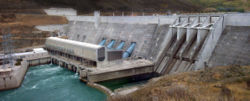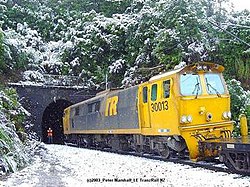Think big
The term Think Big ( English : to think = think , big = large ) describes the economic strategy implemented in New Zealand in the 1980s . At that time, the now largely deregulated and privatized Pacific state was a managed economy whose economy was largely determined by the state. The project, behind Robert Muldoon , then Prime Minister of the New Zealand National Party , was set up to reduce dependence on other countries and to solve the country's enormous economic problems. The project envisaged the construction of oversized industrial facilities and infrastructural improvements.
history

In the late 1970s, the New Zealand economy suffered from several factors:
- the 1973 oil crisis ,
- an extremely high rate of inflation
- the loss of the most important trading partner - Great Britain - after its accession to the European Community .
In 1978 OPEC increased its oil prices again and a year later the Islamic Revolution took place in Iran and that country was no longer producing any oil at that time. In 1979 the second oil crisis was to occur.
The combination of inflation and economic stagnation - in the 1970s established himself for this phenomenon, the portmanteau word " stagflation " - then bothered most of the major industrial countries. The inflation problems were also related to the failure of a system of largely fixed exchange rates (the “ Bretton Woods System ”) that had been established in 1944/45. The system had failed mainly because of the USA, which lived beyond their means (see also Vietnam War , arms race , Apollo program ).
In 1978 Bill Birch became New Zealand's Secretary of Energy. He saw the ample reserves of natural gas around Mount Taranaki as an opportunity for the ailing economy. After another oil crisis began in 1979, the sale of gasoline on public holidays was banned and the Carless Days were introduced . Every private car driver had to do without driving one day a week. Offenses against this ban were punished with heavy fines.
The high oil prices had a negative impact on the already existing foreign trade deficit , as oil imports make up a large part of the country's total imports. The implementation of various think-big projects aimed to reduce the strong dependence on imports (especially in the oil sector), to stimulate the economy and to get closer to a balanced foreign trade balance .
The projects
Three main projects formed the core of the Think Big strategy: These included the expansion of the oil refinery at Marsden Point near Whangarei , the construction of a factory belonging to the Mobil Group for the production of synthetic gasoline and a factory for the production of methanol for the Export. Natural gas from a field in the Tasman Sea was converted into methanol and then further processed into gasoline . However, as oil prices fell again shortly afterwards, the final stage of this transformation became uneconomical and ended soon after. The Clutha River built Clyde dam was then built to the nearby aluminum smelter to be able to provide you with enough energy and now the largest forms hydropower plant in the country.
The individual projects are:
- the methanol factory in Waitara near New Plymouth
- the ammonia / urea oil field in Kapuni near New Plymouth
- a synthetic gasoline production facility in Motunui near New Plymouth
- the expansion of the refinery at Marsden Point near Whangarei
- the expansion of the New Zealand Steel steelworks in Glenbrook near Pukekohe
- the electrification of the North Island Main Trunk between Hamilton and Palmerston North
- the expansion of the aluminum smelter at Tiwai Point near Bluff
- and the Clyde Dam on the Clutha River
Consequences of the think-big era
To date, there is no conclusive study on whether the think-big policy was beneficial to the New Zealand economy or whether it only increased the national debt . Opinions are very divided. While these projects were certainly bad from an environmental point of view, New Zealand's balance of payments problems would have been considerably greater in the late 1980s without these projects. Some of these factories are still generating high profits today, which speaks for their productivity.
Web links
- Techhistory - Think Big (English)

